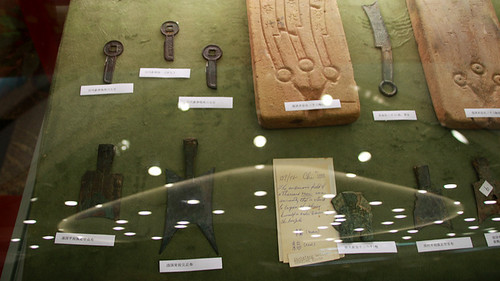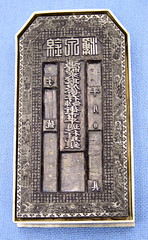
PREV ARTICLE
NEXT ARTICLE
FULL ISSUE
PREV FULL ISSUE
THE HOWARD BOWKER CHINESE COIN COLLECTIONMax Spiegel writes: This is an interesting story from NPR about a Chinese coin collection being donated to the Shanghai Mint by an American family. I thought it might be of interest to E-Sylum readers.

In China, paramilitary police drill outside the Shanghai Mint. They're stationed there because it's literally a moneymaking plant. It's also a museum and, on Friday, it received a new, welcome donation, hand-carried from the U.S. with far less security. Gordon Bowker is one of the founders of Starbucks, although he no longer has any relationship with the company. He and his cousin Carolyn Bowker packed up part of their grandfather's priceless coin collection in their luggage, brought it to China and donated it to the Shanghai Mint Museum. "There really is no better place for the coins to be," says Gordon Bowker. "They would have much less interest to scholars and to the public anywhere else in the world. So it's a natural thing for them to be in Shanghai where they originated." Gordon and Carolyn Bowker's grandfather Howard Bowker joined the U.S. Navy when he was 19 years old and was stationed in Hankou, China, in 1923. He taught himself Chinese, Japanese and Korean. He also began collecting coins, a hobby that Gordon Bowker says married two of his grandfather's greatest passions. "He was fascinated by Chinese history. And he had a big background in money: He was a purser, and a paymaster, and he liked money. I think he liked to count it," Bowker says. The resulting coin collection reflects the past 2,000 years of Chinese history. Its earliest piece is a coin mold dating back to 200 B.C., during the reign of China's unifier and first emperor, Qin Shihuang. Michael Chou from the iAsure Group, which runs an auction house specializing in Asian coins, has been researching the collection for two years. He describes how the coin mold produces multiple coins. "They pour very hot metal into this mold and then a coin tree comes out of this coin mold, and then they break off the coins from the tree individually. So when someone tells you money doesn't grow on trees, it actually does in China," Chou says. Chou says it's impossible to value much of the collection, since the objects are so rare, they seldom are sold on the open market. He says items such as the 2,000-year-old coin mold would be considered a "national treasure" in China. Every coin in the collection is a tangible slice of China's history. One item with immense historical significance is a copper dollar featuring a sailing junk over three flying birds on one side and Sun Yat-sen on the other.
It's a testament to the chaos of China's recent history -- and the flow of valuables beyond its borders -- that the Shanghai Mint Museum didn't have a single example of this historic coin, which was designed in the U.S. by the Philadelphia Mint. Zhang Yueqin is deputy general secretary of the Shanghai Mint's Coin Institute. When asked about the significance of this coin, his voice thickens and he becomes visibly emotional. "We had the mold, but we didn't have a coin," he explains. "The coin has finally come home. It's as if after 80 years a mother is reunited with her child. It's a miracle. The friendship between China and America is embodied in this coin."
"There's no curator of Asian coins at the Smithsonian," Gordon Bowker explains. "Without the staff and the ability to display the coins, it would display much less interest in having that collection." The restitution of valuables to their point of origin is an increasing trend, although in this case, the coins were bought legitimately, not looted.
Who would have thought Starbucks had anything to do with Chinese numismatics?
The Smithsonian's loss is Shanghai's gain, although I wondered how the family managed to override Bowker's will, and diss the more-than-able staff of the National Numismatic Collection. I asked NNC curator Richard Doty, and apparently it was offered to the museum, but when it came before the Collections Committee someone thought "it wasn't 'American' enough." The Shanghai Mint does seem like a very appropriate and appreciative home for the collection, however. Another stop for globetrotting numisma-tourists. -Editor
To read the complete article, see:
Priceless Coin Collection Returns Home To China
(www.npr.org/templates/story/story.php?storyId=126050356)
The Numismatic Bibliomania Society is a non-profit organization promoting numismatic literature. See our web site at coinbooks.org. To submit items for publication in The E-Sylum, write to the Editor at this address: whomren@gmail.com To subscribe go to: https://my.binhost.com/lists/listinfo/esylum All Rights Reserved. NBS Home Page Contact the NBS webmaster 
|

